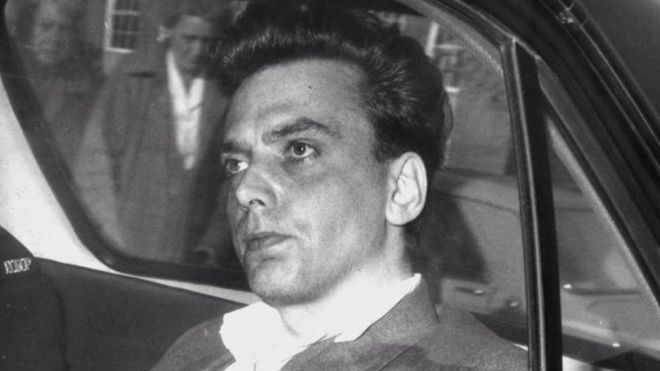Ashes of Moors Murderer were taken by boat from Liverpool Marina in middle of night
The body of serial killer Ian Brady was incinerated and his ashes dumped off Liverpool Bay in a top secret operation around the streets of Merseyside last week.
The remains of the 79-year-old Moors Murderer were taken by boat from Liverpool Marina in the middle of the night, more than a week ago, where they were submerged in a weighted biodegradable urn.
A few hours earlier, also under cover of darkness, Brady’s corpse been had collected from the mortuary at the Royal Liverpool Hospital where it had been stored for five months.
Flanked by a police escort, it was taken to Southport Crematorium. The ashes were then taken in an unmarked police car to Liverpool Marina and up the Mersey for that final act of jettisoning his remains somewhere at sea.

Brady died from natural causes in May and his funeral has taken so long because funeral directors and crematoriums refused to handle his corpse. There were also fears his ashes would be scattered on Saddleworth.
In the end the chancellor of the high court, Sir Geoffrey Vos, ordered that Brady's funeral should be simple and without any typical ceremony to ensure it did not cause offence and distress to the families of his victims.
He also took the responsibility for supervising the task, which had “gone on too long” out of the hands of Brady’s former solicitor and executor, Robin Makin, and placed with Tameside Borough Council.
Liverpool-based Makin had requested that Berlioz’s Symphonie Fantastique should be played at his client’s funeral. This was flatly rejected by Vos who described it as inappropriate and offensive (see panel below).
Vos ruled: “The deceased’s wishes are relevant but they do not outweigh the need to avoid justified public indignation and actual unrest.”
Makin had denied that Brady’s ashes would be spread on Saddleworth but would not say what he intended to do with them if allowed custody.
Vos said at the hearing: “Mr Makin has not been justified in being so secretive about how he was intending to dispose of the deceased’s body.”
Brady’s death in May, at the high security Ashworth psychiatric hospital in Maghull, meant he took to his grave the burial location of 12-year-old Keith Bennett, one of the five children murdered by him and his girlfriend, Myra Hindley, in the mid 1960s. Stephen’s mother had devoted her life to searching for her boy’s body right up until her own death in 2012.
Four of the five children the pair tortured and murdered were interred on the lonely Saddleworth Moor, in Greater Manchester.

The Chester Assizes trial of Brady and Hindley shocked Britain in 1966, with a jury listening to the terrifying last moments of their youngest victim, Lesley Ann Downey, aged 10, captured on audio tape. It reduced the judge, jury and courtroom to tears with John Stalker, former deputy chief constable of Greater Manchester, who was then a detective sergeant, saying: "Nothing in criminal behaviour before or since has penetrated my heart with quite the same paralysing intensity."
Both were sentenced to life in prison, never to be allowed their freedom. Hindley died in 2002.
Brady’s body was collected from the morgue at the Royal Liverpool Hospital by a council official at about 21:00 BST on Wednesday October 25, documents have revealed.
With a police escort his corpse was taken to Southport Crematorium where the cremation began at 22:00 BST, with no music or flowers allowed.
The cremator was then cleaned by professionals
The ashes were then placed in a weighted urn, driven through Liverpool to the marina and dispatched at sea at 02:30 BST.
Vos ordered that the identities of all the officials involved remain secret along with the exact location of the drop.
A joint statement issued by the two local councils most connected with the moors murders, Tameside and Oldham, said: "We are pleased that this matter is now concluded and we are grateful for the support and professionalism shown to ensure Ian Stewart-Brady's body and remains were disposed of expediently at sea in a manner compatible with the public interest and those of the victim's relatives."
Symphony for the devil

As part of his ruling last month, High Court Chancellor Sir Bernard Vos refused Brady’s solicitor and executor, Liverpool based Robin Makin, permission for Berlioz’s Symphonie Fantastique to be played at his client's funeral.
The Guardian quoted Vos: “As to the playing of the fifth movement of the symphony during the cremation, I need only quote the description of that movement from Wikipedia for it to be seen how inappropriate it would be: ‘Fifth movement: Songe d’une Nuit du Sabbat (Dream of the Night of the Sabbath).
In both the programme notes, Berlioz wrote: ‘[The musician] sees himself at a witches’ sabbath, in the midst of a hideous gathering of shades, sorcerers and monsters of every kind who have come together for his funeral.’
“‘Strange sounds, groans, outbursts of laughter; distant shouts which seem to be answered by more shouts.’
“‘The beloved melody appears once more, but has now lost its noble and shy character; it is now no more than a vulgar dance tune, trivial and grotesque: it is she who is coming to the sabbath ... Roar of delight at her arrival ... She joins the diabolical orgy ...’
“‘The funeral knell tolls, burlesque parody of the Dies irae, the dance of the witches …’
Vos concluded: “I have no difficulty in understanding how legitimate offence would be caused to the families of the deceased’s victims once it became known that this movement had been played at his cremation. I decline to permit it.”















